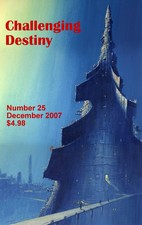


Reviews Home
Columns
Fiction by Title
Fiction by Author
Nonfiction
Movies by Title
Movies by Rating
Audio
Games
Paris in the Twentieth Century, Jules Verne, Random, 1996, 222 pp.
Note: Verne wrote Paris in the Twentieth Century in 1863. This is its first publication.
If anyone has a doubt about Jules Verne's writing power, they should be advised to read Paris in the Twentieth Century immediately. The narrative flows smoothly, this strange Paris is evoked effortlessly, and the ending left me gasping in awe and envy. The book's package is simply gorgeous (artwork by Marc Burkhardt, design by Andy Carpenter), and the margins and print size nearly disguise how short the book is in reality. The blurbs on the dustjacket try and sell the book on its predictive powers, and while, yes, Verne does predict many of our technological advances, that is not the heart of the book. What is? A stinging critique of capitalism, and of the mechanistic worldview underlying progress, all delivered in the form of a strong story.
Paris in the Twentieth Century tells the story of Michel Dufrénoy, a young man who simply does not fit in. He wins a prize for Latin Composition and is roundly booed. He wants to be a writer in a world where writing (as Verne knows it) is dead. He gets a job in a bank, which doesn't last long. When moved on to another job in the bank, he meets Quinsonnas, a pianist who has given up on the old ways and wants to amaze the age. They become friends. Michel also meets his uncle, Huguenin, an eccentric old man with many old style books. At Huguenin's place, he meets Lucy, the daughter of Professor Richelot. Michel falls in love with Lucy, which, indirectly, causes him to lose him job at the bank. He takes up work at le Grand Entrepôt Dramatique (Great Dramatic Warehouse -- think of a nationalized Hollywood), but he is soon disillusioned and decides to venture out on his own as a writer. The ending follows inevitably from there.
We do not really sympathize with Michel Dufrénoy -- more often we condescend to him. He's a dreamy youth, timid at the wrong times (in love and in life), and quite naïve. So in some ways, he's the pawn that Verne sends out to get crushed by a heartless society. But we can understand his dreams, and his fate is still heartwrenching. The other characters are sketched quickly, and Lucy especially is a cipher, put in for plot reasons.
Is Paris in the Twentieth Century as prescient as the blurbs would have us believe? Yes, Verne predicts automobiles, the subway, convenience stores, fax machines, the electric chair, and so on. I can make a far larger list of things that he gets dead wrong -- Quinsonnas' job in the bank struck me as silly -- but the percentage of correct predictions is indeed higher than most science fiction novels. However, I would submit that this is irrelevant, and mostly just a way to fill up the dustjacket description with nice copy. Like this quotation from the inner front: "This astonishing book is comparable to Brave New World and 1984 in its chilling, dystopian view of a future world, and although it predates both novels by at least seventy years, its predictions are much closer to the truth." Big deal. The only reason any of these three books can be discussed together is the force of moral outrage shared by each, the desire to get people motivated to fight the system.
In fact, Verne's predictions, perhaps inevitably, are stuck firmly in his cultural biases. He makes quite a number of excellent projections as to where art (music, literature, painting) will go, and have indeed gone, but he writes them in order to horrify his audience. The irony is intensified when you consider that Verne's editor rejected the book as too unrealistic and pessimistic. For example, Verne mentions several times how dreadful a composer Wagner is, and then extrapolates into the twentieth century. Quinsonnas' piece, "After Thilorier -- A Grand Fantasy on the Liquefaction of Carbonic Acid," actually sounds far more interesting than anything Verne holds up as the idealized time before "sounds gradually gave way to noises whose musical value was no longer appreciable" (96). I also thought that the list of poem titles that Verne wants us to laugh at, and to think along with Michel that "[not] even this tiny amount of art had escaped the pernicious influence of the age" (42) were fascinating and filled with potential. Electric Harmonies could be a book of poetry by Ray Bradbury, Meditations on Oxygen could be about leaving Earth, Decarbonated Odes maybe a schlocky attack on advertising (these three titles are from page 41). Instead, Verne wants to slot music and literature into his general critique of the twentieth century -- it almost works too, except that what he considers a travesty is in fact a kind of flourishing. He needs the repressive society to get his tragic ending, but a more accurate prediction, if that is how we are going to start rating books, would be to have art thriving, subverting/celebrating its context.
Despite a few internal contradictions, and the misleading hype of the publisher, Paris in the Twentieth Century is indeed an important and excellent book. This book stretches Jules Verne's repertory and reputation, and most science fiction authors today could only dream of their books aging 130 years this well. What will Paris look like in the twenty-first century? Maybe there's another Verne manuscript lost somewhere.
Last modified: June 21, 1998
Copyright © 1998 by James Schellenberg (james@jschellenberg.com)

Buy back issues of Challenging Destiny online from:
For the latest information on availability: Where Can You Buy Challenging Destiny?